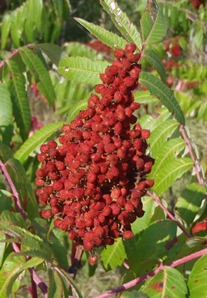Fall can be so beautiful, with some years more colorful than others depending on the weather. Many of us love the fall due to the many colors we see in our environment. Sumac, a plant that turns a brilliant red color in the fall, is a great addition to any acreage.
Sumac plants have compound leaves with 9-11 leaflets for most species. The number of leaflets depends on the variety. Sumac leaves are 12-24 inches long. The plant usually is grown as a large shrub or small tree, and typically will spread into a colony of many plants through suckers. Sumacs turn bright red or orange red in the fall, making them a great plant for autumn interest. The flowers of sumac are very small and white, held in a dense cluster about 4-8 inches tall. Brick red fuzzy fruits develop in late summer and persist into the winter, according to the Field Guide to Trees of North America.
The many varieties of sumac provide planting opportunities for the acreage landscape as well as urban setting. According to Kim Todd, University of Nebraska-Lincoln Professor of Horticulture, smooth sumac, Rhus glabra, and staghorn sumac, Rhus typhina, are both bright red in the fall. While very similar, the staghorn sumac has light fuzz all over the branches. Both staghorn and smooth sumac have a variety or cultivar 'laciniata' with more divided leaves. Both sumacs grow very tall, up to 15 feet or more.
Flameleaf or shining sumac, Rhus copallina, has more orange and red color in fall and the leaves are smooth and shiny on the top side, as the name implies. Aromatic sumac, Rhus aromatica, is named for the aromatic scent that it has when the leaves or stems are bruised. Aromatic sumac is shorter: it only grows up to 6 feet tall. It has an even shorter cultivar called 'Gro-Low' that only grows to 2-3 feet tall but gets up to 8 feet wide. Aromatic sumac has trifoliate leaves, which means they are compound similar to poison ivy, while the other three sumacs have compound leaves with more leaflets.
Sumac grows almost anywhere - along the roadsides in ditches and almost as a weed on the edge of or within forested areas. Sumac is widespread because it can adapt to almost any type of environmental condition. It can withstand almost anything, except permanently wet soils. According to Kim Todd, sumac is a tough plant that is hard to kill.
Native to Nebraska, sumac is a great food resource for wildlife. Many birds eat the berries, while sheep, deer, and rabbits may eat its leaves. In addition, sumac provides shelter for wildlife and livestock. Historically, Native Americans used the fruit to make a citrus-flavored drink. They also smoked the leaves and used the stems to make a yellow dye.
Sumac is adaptable to many different areas. Its red color in fall adds a great deal of interest to any landscape. The next time you want to add a plant to your acreage that is easy to grow, look to the sumac. There are so many choices that you can even add a few different types to your landscape.


